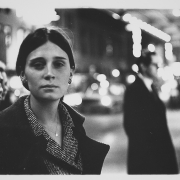Re:Collection: Sophia Pennex on Rita Hammond
Visitors to our website are invited to explore thousands of photographic works and objects from the Light Work Collection in our online database that expands access of work by former Light Work artists to students, researchers, and online visitors. To coincide with the our collection website launch, we’re introducing a series on our blog called Re:Collection, inviting artists and respected thinkers in the field to select a single image or object from the archive and offer a reflection as to its historical, technical, or personal significance.
Today we’re sharing a reflection on Rita Hammond’s Images of a Girl series from Sophia Pennex. Pennex is a freshman in Syracuse University’s Maxwell School of Citizenship and Public Affairs and Renée Crown Honors Program.
Rita Hammond’s photography series, Images of a Girl (1967), emphasizes the unguarded emotions of her subjects, caught unaware. Like many in the series, this image is raw and powerful, with a quality of suddenness. The organic and candid emotions of the young girl and the blurriness of the gentlemen in the background both attract the viewer’s attention. Co-author of the definitive book about Hammond’s work as well as her friend, Gina Murtagh told me that this image reminds her of a Martin Scorsese film. The men surrounding the girl create a sense of danger, yet she has a slightly defiant look on her face. Murtagh describes the face as young and impressionable.
But the street photography qualities of this image make it hard to tell what is actually happening in this scene. Murtagh described street photography as always trying to catch something and this image embodies this idea. The girl in the front—who is, in fact, one of Hammond’s long-time friends, Lynn Moser—is the only subject in focus. The setting of a busy street, likely 42nd street, and the background of people in motion, give the photograph an overall rushed tone. The juxtaposition of Moser’s in-focus face and startled expression with the rushing, blurry background crowd, provokes our speculation about what may just have happened and what the emotions on Moser’s face actually mean. This image makes us feel a personal connection to Moser. The interesting thing about such identification with Moser is that this experience—a momentary glimpse of a stranger in passing—is not new to us, yet how often do we develop these connections and interests in others? Others constantly surround us—at least if we occupy an urban environment—but how often do we actually look at each other?
We walk by other people many times in a day. Whether we are in a city or on campus, we are almost always near other people, but constant proximity is not the same as constant human contact. Sure, we may smile or wave to a friend or neighbor, but greeting a stranger is uncommon. As I walk through campus, I see many stone cold and dismissive faces. Everyone seems so engrossed in their own thoughts that I start to feel invisible.
This image captures the experience of escalating mutual invisibility. Our constant, self-absorbed hustle deadens our curiosity about the lives of others. Yet without our attention, other people may start to feel unseen too, turning ever more inward. This is a vicious cycle. However, Rita Hammond encourages us to break this cycle. Her images seize us abruptly and demand we look at one another and makes us realize that we are not alone in this chaotic world.
Find more of Rita Hammond’s work online here.
Explore the Light Work Collection online at http://collection.lightwork.org

